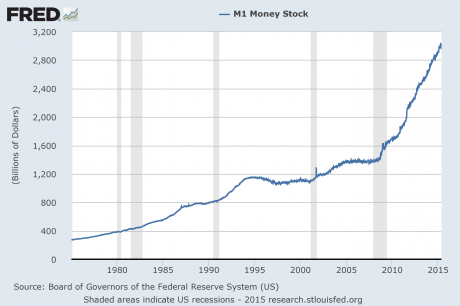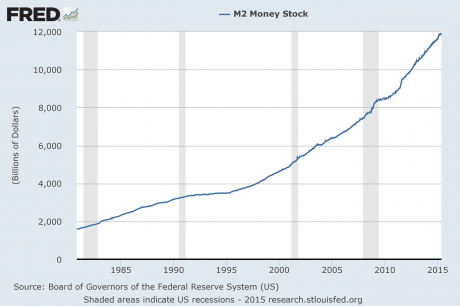Did you know that if you took every single penny away from everyone in the United States that it still would not be enough to pay off the national debt?
Today, the debt of the federal government exceeds $145,000 per household, and it is getting worse with each passing year. Many believe that if we paid it off a little bit at a time that we could eventually pay it all off, but as you will see below that isn’t going to work either.
It has been projected that “mandatory” federal spending on programs such as Social Security, Medicaid and Medicare plus interest on the national debt will exceed total federal revenue by the year 2025. That is before a single dollar is spent on the U.S. military, homeland security, paying federal workers or building any roads and bridges.
So no, we aren’t going to be “paying down” our debt any time in the foreseeable future. And of course it isn’t just our 18 trillion dollar national debt that we need to be concerned about. Overall, Americans are a total of 58 trillion dollars in debt. 35 years ago, that number was sitting at just 4.3 trillion dollars. There is no way in the world that all of that debt can ever be repaid. The only thing that we can hope for now is for this debt bubble to last for as long as possible before it finally explodes.
It shocks many people to learn that our debt is far larger than the total amount of money in existence. So let’s take a few moments and go through some of the numbers.
When most people think of “money”, they think of coins, paper money and checking accounts. All of those are contained in one of the most basic measures of money known as M1. The following definition of M1 comes from Investopedia…
A measure of the money supply that includes all physical money, such as coins and currency, as well as demand deposits, checking accounts and Negotiable Order of Withdrawal (NOW) accounts. M1 measures the most liquid components of the money supply, as it contains cash and assets that can quickly be converted to currency.
As you can see from the chart below, M1 has really grown in recent years thanks to rampant quantitative easing by the Federal Reserve. At the moment it is sitting just shy of 3 trillion dollars…
So if you gathered up all coins, all paper currency and all money in everyone’s checking accounts, would that even make much of a dent in our debt?
Nope.
We’ll have to find more “money” to grab.
M2 is a broader definition of money than M1 is, because it includes more things. The following definition of M2 comes from Investopedia…
A measure of money supply that includes cash and checking deposits (M1) as well as near money. “Near money” in M2 includes savings deposits, money market mutual funds and other time deposits, which are less liquid and not as suitable as exchange mediums but can be quickly converted into cash or checking deposits.
As you can see from the chart below, M2 is sitting just short of 12 trillion dollars right now…
That is a lot more “money”, but it still wouldn’t pay off our national debt, much less our total debt of 58 trillion dollars.
So is there anything else that we could grab?
Well, the broadest definition of “money” that is commonly used is M3. The following definition of M3 comes from Investopedia…
A measure of money supply that includes M2 as well as large time deposits, institutional money market funds, short-term repurchase agreements and other larger liquid assets. The M3 measurement includes assets that are less liquid than other components of the money supply, and are more closely related to the finances of larger financial institutions and corporations than to those of businesses and individuals. These types of assets are referred to as “near, near money.”
The Federal Reserve no longer provides charts for M3, but according to John Williams of shadowstats.com, M3 is currently sitting somewhere in the neighborhood of 17 trillion dollars.
So even with the broadest possible definition of “money”, we simply cannot come up with enough to pay off the debt of the federal government, much less the rest of our debts.
That is not good news at all.
Alternatively, could we just start spending less than we bring in and start paying down the national debt a little bit at a time?
Perhaps that may have been true at one time, but now we are really up against a wall. Our rapidly aging population is going to put an enormous amount of stress on our national finances in the years ahead.
According to U.S. Representative Frank Wolf, interest on the national debt plus “mandatory” spending on programs such as Social Security, Medicare and Medicaid will surpass the total amount of federal revenue by the year 2025. That is before a single penny is spent on homeland security, national defense, paying federal workers, etc.
But even now things are a giant mess. We are told that “deficits are under control”, but that is a massive hoax that is based on accounting gimmicks. During fiscal year 2014, the U.S. national debt increased by more than a trillion dollars. That is not “under control” – that is a raging national crisis.
 Many believe that that we could improve the situation by raising taxes. And yes, a little bit more could probably be squeezed out of us, but the impact on government finances would be negligible. Since the end of World War II, the amount of tax revenue taken in by the federal government has fluctuated in a range between 15 and 20 percent of GDP no matter what tax rates have been. I believe that it is possible to get up into the low twenties, but that would also be very damaging to our economy and the American public would probably throw a huge temper tantrum.
Many believe that that we could improve the situation by raising taxes. And yes, a little bit more could probably be squeezed out of us, but the impact on government finances would be negligible. Since the end of World War II, the amount of tax revenue taken in by the federal government has fluctuated in a range between 15 and 20 percent of GDP no matter what tax rates have been. I believe that it is possible to get up into the low twenties, but that would also be very damaging to our economy and the American public would probably throw a huge temper tantrum.
The real problem, of course, is our out of control spending.
During the past two decades, spending by the federal government has grown 63 percent more rapidly than inflation, and “mandatory” spending on programs such as Social Security, Medicare and Medicaid has actually doubled after you adjust for inflation.
We simply cannot afford to keep spending money like this.
And then there is the matter of interest on the national debt. For the moment, the rest of the world is lending us gigantic mountains of money at ridiculously low interest rates. However, if the average rate of interest on U.S. government debt was just to return to the long-term average, we would be spending more than a trillion dollars a year just in interest on the national debt.
So the best possible environment for “paying down our debt” that we are ever going to see is happening right now. The only place that interest rates on U.S. government debt have to go is up, and our population is going to just keep getting older and more dependent on government programs.
Meanwhile, our overall debt continues to spiral out of control as well. According to CNBC, the total amount of debt that Americans owe has reached a staggering 58.7 trillion dollars…
As the nation entered the 1980s, there was comparatively little debt—just about $4.3 trillion. That was only about 1.5 times the size of gross GDP. Then a funny thing happened.
The gap began to widen during the decade, and then became basically parabolic through the ’90s and into the early part of the 21st century.
Though debt took a brief decline in 2009 as the country limped its way out of the financial crisis, it has climbed again and is now, at $58.7 trillion, 3.3 times the size of GDP and about 13 times what it was in 1980, according to data from the Federal Reserve’s St. Louis branch. (The total debt measure is not to be confused with the $18.2 trillion national debt, which is 102 percent of GDP and is a subset of the total figure.)
As I discussed above, there isn’t enough money in our entire system to even pay off a significant chunk of that debt.
So what happens when the total amount of debt in a society vastly exceeds the total amount of money?
Is there any way out other than collapse?
You can share what you think by posting a comment below…
This article first appeared here at the Economic Collapse Blog. Michael Snyder is a writer, speaker and activist who writes and edits his own blogs The American Dream and Economic Collapse Blog. Follow him on Twitter here.




This is the thing that folks much smarter than me don’t understand.
The globalist’s intention is to crash it.
They don’t want to remodel America.
They want a whole new structure.
So there’s demolition to do.
That’s what we’re witnessing.
The deliberate, carefully orchestrated demo of our Country.
Crash the old.
Usher in the new.
The New World Order.
Sad but true there will be no good future for our children and grandchildren if they get their way.
Good column. However, I disagree with:
The only thing that we can hope for now is for this debt bubble to last for as long as possible before it finally explodes.
No. The longer the bubble lasts, the worse the explosion will be. Better sooner than later.
When will the ‘sleepy heads’ WAKE UP!… & realize that this is all purely a ‘smoke & mirror’ financial fabrication …a byproduct of abject Usury via the fallacious ‘Debt & Interest’ construct; that has been foisted upon us all by the same scum bag psycho/psychopath junk yard dog Zionists… that deliberately False-Flaged-> then hijacked the US Federal govn’t on 9-11….it’s all a smoke & mirror Grand Illusion…pixels on a screen…this debt is NOT Real….it’s only a perverse & insidious agreement between reptiles & vipers.
Obumma is doing a great job…his contract is to destroy the USA….this is fair payback for the robbing, raping, burning and murdering carried out by the American people against the rest of the world. The old excuse..”.it’s not the average American that is responsible”….is no excuse. How can you ‘excuse’ genocide? If you ‘ average Americans ‘ don’t have the balls to hang your criminal bankers, corrupt congressmen, CIA grubs, Rockefellers, Bush’s, Clintons….you will pay the price. The cost of burning children, dismembered…starved…orphaned…in all countries….by you and your agents…the chickens are coming home to roost.
You’re conflating SS with the discretionary budget SS is paid through FICA and will be solvent through 2036. Medicare is also paid by a dedicated tax. The problem is the discretionary budget and the tax cuts that have been made in it. The argument about ‘never’ being able to pay down the deficit was the argument made against the New Deal, and it was false–the New Deal and WWII would have been paid off by the 60’s but for new spending on the Cold War.
There are some good ideas on how to solve the world’s messed-up financial system at Positive Money Org
The debt will disappear along with the dollar, swept away by an hyperinflation tsunami. Then it will be the time for the patriots to rebuild their nation.
Another way?
The Treasury creates a new currency. Lets call it the Lincoln in the US and the Crown in the UK and the Mark in Germany. Each of the new currencies is denominated: $50 = Lincoln, £50 = 1 Crown, 50 Euros = 1 Mark.
Each printed note includes the words: “This note is the property of the Treasury” and “Non Exige” (latin – no interest).
The respective governments helicopter some of the new currency (5% of M1) into the economy to the people. It is happily accepted as all government departments will accept the new currency at the declared face value. People spend some and pay off some debt. The government also initiates a new program of public works and spending on high tech R&D using the new currency. We have actual useful stimulus of the economy.
The banks can use the new currency as part of their reserves but cannot lend out the new currency at interest. Later on when the banks have been separated into commercial lending banks and investment banks the commercial banks will be allowed to lend out the new currency without interest. They retain part of the repayments as their profits. Instead of interest rates the treasury now sets a new variable: the Bank Retention Rate, i.e. the rate at which banks retain repaid principle. This is a neat tool. Putting the rate high allows riskier lending, low and moral hazard is reduced. This gives the Treasury control of the stimulus rate and the banks oversight of moral hazard.
Gotta go now, the rest is easy…
Similar to what was done in Germany after the deutschmark crashed. The very same bank issued another fiat currency called the reichsmark, and all was well. The band played on, same game, different uniforms.
First of all, it’s super easy for the government to pay debt, since it can just print up the money. The “impossibility” is false, because debt gets paid in either of two ways. Either it does, or it does not. See, the not way? That’s a way. It’s called bankruptcy. So, the two ways are either print the cash, or declare bankruptcy. On the extreme, you print up all the money at once, and actually pay back people who paid into Social Security in one lump sum, and let them invest it or whatever, but that would be a radical pay back method, and nobody has ever advocated that. Or, you just stop paying them, and this is always threatened, but never done. So, they muddle through in the middle, just printing enough to keep the system going while warning of deflation while they inflate like crazy. As long as they decieve the 99% as to what they are doing, silver will remain under $500/oz. After 1% of the money starts buying silver though, silver prices will rise from under $20/oz. as they are today to over $500/oz.
So with the hyperinflation that will eventually result, as when 1% of the people try to cash out, and push silver prices to $500/oz. and beyond, what happens is that people who are “being paid” will be not paid, since their purchasing power will be quickly vanishing. And then, the cost of living adjustments will rise to meet the inflation, and then the built in cost of living adjustments will crash the system of paper money even faster. So, in this way, people are “paid cash” but if the cash quickly become worth less and less as inflation soars over 10% per month, then the system crashes with hyperinflation and people not being paid value, even as they are being paid in paper.
No, the real problem is Usury.
Most Western Governments have paid more Usury on their national debts since the war than they have debts outstanding. Meaning they wouldn’t have debts, if they could finance interest-free.
A 200k Mortgage costs 300k Usury over 30 years. Meaning Usury is the main cause of the massive private debt.
Producers pass on their cost for capital to consumers. It has been established that no less than 40% of prices is Usury passed on in the prices we pay for our daily needs.
All this money ends up with the Banks and by extension their very wealthy owners.
It’s time you start talking about this Michael.
Central banks are private corporatations that have never paid tax. Backdate the tax to their inception & levy money out of them.
Also, introduce NIRP to account deposits of the rich, 1st in exchange for low quality derivatives & junk bonds that broke the banks, then the better quality assets for the poorer rich, then Treasuries for middle class.
The rich will have a choice: Invest in junk or spend.
They will have to be locked in for a number of years.
If the economy improves they may get some value but it’ll be in the distant future.
At the same time, introduce higher rates for poorer savers in order to stimulate the economy.
I call this scheme: Robin Hood Interest Rate Policy #RHIRP